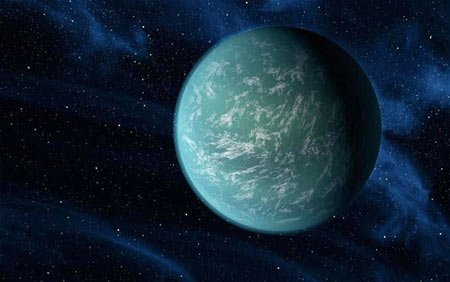|
 Kepler is searching for planets as small as Earth, including those orbiting stars in a warm, habitable zone where liquid water could exist on the surface of the planet. |
|
A planet more like Earth than any yet discovered has been identified as a potential future home for mankind. Kepler 22b contains both land and water and has temperatures which average around 72 degrees (22 Celsius). It also contains the right atmosphere to potentially support life. It is, however, 600 light years from Earth. The planet, where a year lasts 290 days, was first spotted two years ago. However, Nasa scientists using the agency’s Kepler space telescope have now concluded that it offers the best hope yet for future human habitation outside the Solar System. One of the key criteria for a planet to be habitable is that it remains roughly the right distance from its main star to be neither too cold nor too hot. This range of ideal temperatures is known to scientists as the “Goldilocks” zone, as the temperature is “just right” for life. Bill Borucki, Kepler principal investigator at NASA Ames Research Centre, said: “We have now got good planet confirmation with Kepler 22b. “We are certain that it is in the habitable zone and if it has a surface it ought to have a nice temperature.” There are now three planets outside the system, known as exoplanets, which experts believe could potentially be colonised by future generations. In May, French astronomers identified Gliese 581d, pronounced “gleezer”, which is far closer at around 20 light years away. It is about six times the mass of Earth and is one of a family of at least six planets. In August, a team from Switzerland reported that another planet called HD 85512b and 36 light years away seemed to be habitable. The planet is in the constellation of Vela, measures around 3.6 times the Earth's mass. According to an online catalogue that indexes bodies outside our solar system by the Planetary Habitability Laboratory (PHL) of the University of Puerto Rico at Arecibo, a total of 47 exoplanets and exomoons are potential habitable candidates but not enough research has been done to be sure. (Read by Emily Cheng. Emily Cheng is a journalist at the China Daily Website.) (Agencies) |
天文學家最新發現了一顆被認為是迄今為止和地球最為相像的行星,而且被視為可能成為人類未來的居住地。 這顆名為“開普勒22b”的行星包含陸地和水,平均氣溫在72度(22攝氏度)左右。 該行星還擁有能維持生命的大氣。 不過,這顆行星距離地球長達600光年。 這一行星兩年前被首次發現,該行星上的一年為290天。 現在,美國宇航局的科學家用宇航局的開普勒太空望遠鏡勘測后得出結論,稱這一行星是太陽系以外最有希望成為未來人類居住地的星球。 一顆行星是否宜居的關鍵標準之一是和主恒星的距離要適當,既不過冷,也不過熱。 這一理想溫度的范圍被科學家稱作“金鳳花區”,這一溫度區域對生命“正合適”。 美國宇航局艾姆斯研究中心的開普勒項目負責人比爾?伯魯奇說:“我們現在已經證實‘開普勒22b’適合居住。” “我們確定該行星位于宜居區域內,如果這一行星有地表的話,溫度會很適中。” 目前太陽系外有三顆“系外行星”被專家認為人類未來可能移居。 今年五月,法國天文學家發現宜居行星“格利澤581d”,該行星比“開普勒22b”要近得多,距離地球約20光年。 “格利澤581d”的質量約為地球的六倍,是一個包含至少六顆行星的家族中的一員。 今年八月,來自瑞士的一個研究團隊報告稱他們發現了另一個疑似宜居行星“HD 85512b”,距離地球36光年。 該行星屬于船帆星座,質量約為地球的3.6倍。 據阿雷西沃波多黎哥大學的行星適居性實驗室在網上發布的太陽系外天體目錄,共有47個系外行星和系外衛星可能是宜居星球,不過還需更多研究才能加以確定。 相關閱讀 (中國日報網英語點津 陳丹妮 編輯:Julie) |
|
Vocabulary: goldilocks: 金鳳花 exoplanet: 太陽系外行星(簡稱系外行星) mass: 質量 constellation: 星座,constellation of Vela是船帆座。 index: 把……編入索引 exomoon: 太陽系外衛星(簡稱系外衛星) |
